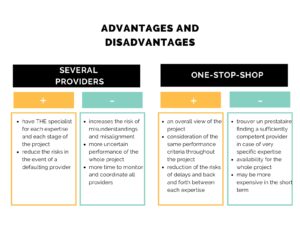You have an innovative project, the design of an intelligent product and you are looking for a service provider to accompany you. One or more service providers. This is where the first question arises: who to choose and on what
You have an innovative project, the design of an intelligent product and you are looking for a service provider to accompany you. One or more service providers. This is where the first question arises: who to choose and on what

You have an innovative project, the design of an intelligent product and you are looking for a service provider to accompany you. One or more service providers.
This is where the first question arises: who to choose and on what criteria should you base your choice of IoT service provider?
Should you choose several service providers specialising in each IoT field or limit the number of people involved and choose a single service provider?
In other words, what are the advantages and risks of a one-stop shop? If you are asking yourself these questions, you are in the right place!
In this article, we “dissect” the one-stop shop.
The aim: to help you make the best choice for your project.
This means bringing most services under one roof. We can also talk about a “one-stop shop”.
An IoT (Internet of Things) project involves multiple areas of expertise: hardware, software, firmware, connectivity, cloud, manufacturing, etc. Instead of calling on a different expert for each area, IoT project managers are increasingly opting for “one-stop shop” providers.
In this article, find out what these “one-stop shops” can do for you and how they make it easier to design connected objects.
For a connected object project, it is not uncommon to involve several service providers. Even for companies with an in-house technical team, you can use service providers to bring you additional expertise.
Whether it’s for the entire development of your solution or just part of it, you have several choices of service providers.
But here, let’s go further.
Beyond the status of the provider company, the question is the following:
Is it in your interest to go for THE specialist in each expertise needed to develop your project? If so, do you need to hire several people (one for each expertise)?
Hiring several providers is still the default solution.
After all, it’s rather logical and mathematical: add up the expertise to ensure you have a high-performance solution.
For example:
Many IoT service providers are specialise in software and firmware. Others deal exclusively with hardware, whether it be connected or standard objects.
We have often been recognised for our hardware skills and have therefore only been asked to provide hardware services.
You can therefore call on several specialised service providers, each of whom is individually enlisted for each area of expertise.
It’s only natural!
| Beware of predetermind ideas!
The choice to turn to multiple service providers could be based on the traditional saying: never put all your eggs in one basket. However, this idea is often deceptive. Why? Because of the complexity and interconnectedness of IoT expertise/businesses. Indeed, the real complexity and challenges of your IoT project lie in moving forward in a coordinated manner. We’ll go into this in a bit more detail later in this article. However, you can already see that coordinating several companies is more complicated and risky. |
The advantage of this choice:
We think this is a good choice if you are looking for very specific and uncommon expertise. For example, a service provider that uses Microsoft Azure edge technology or a Machine Learning specialist.
However, for the majority of projects, the choice of a service provider integrating all the IoT professions may be more effective. This is the one-stop shop.
To be clear about the definition: a one-stop shop is a single point of contact that offers a whole range of interconnected services.
Applied to the IoT, this “one-stop shop” consists of a unified service provider capable of managing all the stages of a connected object project. It is capable of implementing, designing and reporting to the client at all stages of the development of the connected solution.
Choosing the one-stop shop = choosing a multi-skilled service provider.
Each area of the IoT is mastered independently by various players. There are specialists in cloud, mechanics, connectivity, firmware, hardware, software, R&D, mechanics, etc.
The complexity of an IoT project lies above all in the permanent interconnection between these professions. To succeed, the various businesses must move forward in a coordinated manner, avoiding segmentation into sub-projects.
This is THE main difficulty to integrate into your IoT project.
We talk about it in particular in this article on mobile development. Very often in a connected object project, we tend to place the development of a mobile application at the back of the queue.
Why is this? Perhaps because we think that the development of a mobile application is not that complex and will fit well into the final product or prototype. However, not thinking about the mobile application at the design stage often sidelines features that should be integrated by the firmware. That is, from the early stages of design.
This example (among many others) shows that, when businesses communicate badly, the risk is to generate components that do not work together.
In this case, you have to go back and forth between each expertise over and over again.
In addition to extending the timeframe, this can lead to a loss of focus on the overall results and profoundly alter the expected ROI.

As a single provider, the one-stop shop offers a cross-functional approach that reduces setbacks and misunderstandings. It smoothes out the complexity of each business line while maintaining an overall view of the project at all times.
We told you about the main advantage of using the One-Stop-Shop for your IoT project: synchronising expertise and therefore protecting and integrating the performance criteria of your solution.
A service provider who manages several stages of the project often makes it possible to effectively reduce the overall duration. A one-stop shop will better harmonise expertise, much better than several independent service providers who discover each other for the occasion.
The multi-skilled service provider is able to adapt and react more quickly according to the needs and progress of the project. This is an asset for better managing the critical phases of an IoT project: the return of the first prototypes, lab tests, etc.
A single service provider will :
These points are essential for your project.
Very often, IoT experts make choices based on the performance of their scope. This is logical but it is a danger for the project as a whole.
For example, we have already had cases where a firmware modification, although deemed relevant, could block a cloud functionality in the future.
CLIENT CASE: COMMITMENTS AND ALIGNMENTSWe had a project where we were only in charge of hardware development. The client had selected other providers for the other business bricks. A few weeks after its launch, the project was held up by a complete misalignment between the players. We (for the hardware aspect/element) had a commitment to fees success criteria.. This was not the case with other providers. The methods of engagement were not aligned. So the performance criteria were not totally aligned. In the end, the client decided to entrust us with new components: the firmware part and the cloud and mobile management. We were thus able to support them in harmonising practices and modification requests for the entire project. This alignment work allows us to have a “go/no-go” view of the modifications, i.e.: such and such functionality is compatible (or incompatible) for such and such a business. In short, we are not looking for the best solution for this or that business but the best solution for the final product. |
Using a single experienced provider saves time at the start of the project. You can present your vision, instructions and objectives in one go (instead of repeating them for each provider).
During development, the one-stop shop ensures a clearer and lighter project architecture for the client. The client follows the progress of the project but is not obliged to make/create the interface between each of the parties involved.
Another advantage: with a full-service provider, there is less risk of budget changes during the project, as happens in the case of disagreements and delays, reformulation of objectives, return of prototypes, etc…
Indeed, when synchronisation between the business lines is insufficient, the project timing can quickly get out of control, with accumulated delays blowing the initial budget.
However, the cost of the project depends on other factors, including the type of contract with the one-stop shop provider (see below).
An experienced multi-skilled partner reduces the risk of latency or blockage. It ensures better communication between the various business lines, which are used to working together on tight deadlines. This is all the more important when meeting tight deadlines is a priority for the project.
In the case of the development of this connected tyre for Formula E, the main objective was to offer an operational product for the start of the season. Rtone provided service as a multi-skilled one-stop shop. Mechanics, software layers, connectivity, business applications: the consolidation of different phases of the project within a single service provider allowed for maximum optimisation of deadlines and the delivery of a connected tyre in a record time of 12 weeks, within the allotted time.
> Discover the connected tyre project – Michelin Formula E
As a multi-skilled provider, it is much easier to align your vision of the project with that of the client.
With multiple specialist providers, mathematically, there is a greater risk of misunderstanding the final objective or of different objectives for each business. With a one-stop shop, it is easier to convey a clear understanding of the results and commitments to the provider.
This is the choice made by the project leader La Grangette.
This multidisciplinary project included the participation of Rtone in the following aspects: mechanical; R&D, hardware, firmware and cloud. The UX was carried out with a three-way collaboration with the client and Pininfarina.
Thibaut Pradier, CEO of La Grangette (the client), came with 1 budget, 1 vision and 1 deadline. He needed commitment around these 3 pillars. He chose to stay with Rtone on a One-Stop-Shop basis to limit the risks.
> Discover the history of the La Grangette project.
The choice of a multi-skilled IoT provider is even more important when it is a “one-stop shop”! Indeed, when you put “all your eggs in one basket”, a casting error can compromise the whole connected object project.
The important thing is to ensure that the IoT service provider is reliable and experienced, particularly on the basis of its portfolio.
The ability to meet your challenges must be a priority. Each IoT project is different. Is the service provider able to respond to the added value of your specific connected object? Home automation, global connectivity, low-power IoT, etc. It is essential that the service provider is capable of delivering a successful service in terms of your added value.
This can be explained very simply by the fact that you don’t have to coordinate various service providers and do a sort of permanent “puzzle” to put the components of your project back together, spread out among various players.
Whoever your service provider is, they must be able to integrate your own business skills. Here, the human factor is essential. Whether it is mechanics, hardware, firmware, software, or cloud, etc. your expertise must be able to interact with theirs to give the project your own colour.
Similarly, exchanges with your service provider will be crucial to anticipate the maintenance of your intelligent object. Here too, this subject can be anticipated and taking your expertise into account from the start of the project is a prerequisite.
Budget and ROI: the best way to monitor your budget
The budget is certainly a central criterion that will guide your choice of provider.
However, to be more precise, we will talk more about ROI. More than the amount of the engineering service, we advise you to take the time to determine the projected profitability of your project and your final product.
This method is an ally for your decision-making. More than a budget line, you can evaluate your choices in terms of expected profitability.
> Learn more and read the article on the return on investment of your IoT project.
Is the one-stop-shop cheaper than choosing several providers?
You might think that the one-stop-shop would be cheaper. Certainly, a one-stop shop provider allows one share certain costs compared to multiple providers, which allows one to optimise the budgets.
Bad news: it’s not necessarily cheaper in the short term!
Why not?
Because the budget for a “one-stop shop” service takes into account the intersections of the scope of each business. The more comprehensive the project, the more extensive the budget, sometimes with a cost that matches the advantages mentioned above.
This point is very important because, very often, if you are dealing with several providers, it is very difficult to estimate these costs. And there is a risk of having an unpleasant surprise and exceeding the budget.
In short, the cost may be significantly higher, but it is less subject to the vagaries and allows you to calculate and monitor your ROI more accurately.
Our advice: think long-term when preparing your budget and studying the proposals of the service providers consulted.

According to a Cisco survey, only 26% of IoT projects were reportedly completed in 2017. Of course, this figure is set to rise with the latest IoT 2021 trends and increasingly mature markets.
Nevertheless, it is important to integrate risk analysis into one’s IoT project and to relate it to the committed budget, to ensure the overall ROI of the project.
Is security respected?
Connected objects have new entry points that need to be secured to ensure that the system is not vulnerable. Carrying out your smart product project requires you to plan for the security of the object but also the protection of user data and cybersecurity issues.
A central question when choosing your IoT provider is here: Are the cybersecurity issues well taken into account by your provider(s)?
As a one-stop shop, there is little room for error. The security of exchanges, data and access must be a focal point:
It is not an easy decision to outsource such a large part of your project. By transferring it to a single “one-stop shop” provider, there is a risk of disappropriating the project.
On the contrary, the added value of a multi-skilled service provider must also include an understanding of your company culture and brand vision.
In our opinion, this is essential to the success of your project and, ultimately, of your intelligent solution.
So whether you choose a single provider or not, one of the strategic evaluation criteria would be their flexibility. Flexibility or adaptability to enable the delivery of a product that fits you exactly.
How can this be translated into concrete terms?
This can be done by :
On this point, we could go much further, but that will be the subject of a future article!
If we only take one thing away from this article on the interest of the one-stop shop for an IoT project, it would be the image of the conductor: managing to tune and synchronise all the expertise as well as possible.
To guarantee the success of a connected object project, the one-stop shop has many advantages: performance, ROI, protection of your budget and security. By using an experienced and flexible partner, the one-stop shop secures the success of your IoT project.
Un peu de lecture
Des articles, des podcasts, des webinars… et surtout des conseils pratiques ! En bref, une collection de ressources pour mener à bien votre projet.